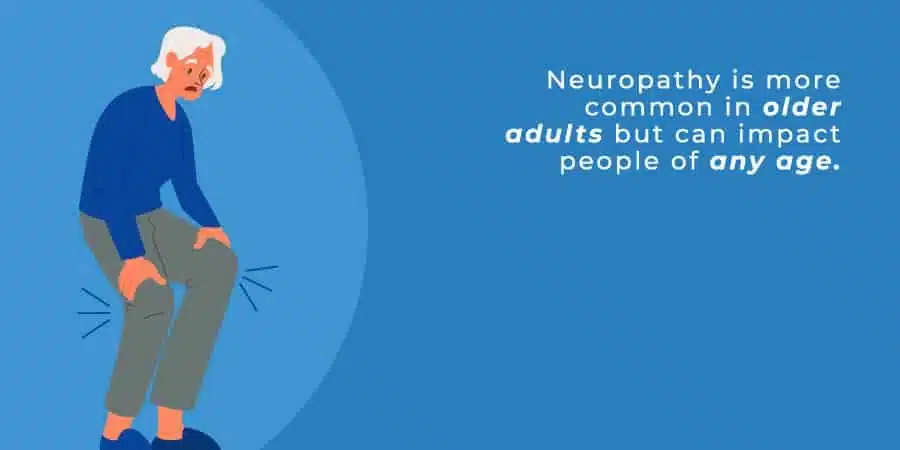

What Is Neuropathic Pain?
What Is Neuropathic Pain?
Learn about peripheral neuropathy and the recommended methods of treating neuropathic pain.
Table of Contents
Defining Neuropathic Pain
A shooting or scorching sensation is a common description of neuropathic pain. It can seemingly resolve independently, but it’s usually a long-term problem. The pain can be relentless and terrible, but it can sometimes diminish and become manageable at times.
Nerve injury or a dysfunctional nervous system are common causes of neuropathic pain. Nerve damage results in alterations in nerve function both at the injury site and in the surrounding tissues.1
Peripheral Neuropathy
Peripheral neuropathy is when the nerves tasked with carrying information to and from the brain, spinal cord, and other parts of the body are damaged or diseased.2 The peripheral nerves are complex and connect the brain to other vital parts of the body, including skin, muscles, and internal organs. They come out of the spinal cord and are set up along certain body parts referred to as the dermatomes.
Damage usually affects more than just one dermatome. The impact stops communication between the brain and other areas of the body, leading to damaged muscle movement, pain, and abnormal sensations in the legs, arms, and other parts of the body. The nerve pain and neuropathic pain associated with peripheral neuropathy are considered some of the worst someone can experience.
Neuropathic Pain vs. Peripheral Neuropathy
What is the difference between neuropathic pain and peripheral neuropathy? What are the most prominent neuropathic pain symptoms and causes?
Essentially, neuropathic pain is caused by nerve damage, while peripheral neuropathy is caused by a lack of communication between the brain and other parts of the body. Though, the symptoms can be the same.
The symptoms of peripheral neuropathy can range from mild to life-threatening, meaning it can be a very serious condition and should be treated and taken care of by a medical professional.
A Further Look at Neuropathic Pain
Types of Peripheral Neuropathy
Motor Peripheral Neuropathy
The motor neuropathic nerves of the body control conscious movements. They send signals throughout the body and control the muscles that allow any type of movement. When these motor nerves are damaged, the body faces an inability to move voluntarily. There are many symptoms, including extreme muscle weakness, cramps, twitches, and muscle shrinkage.
Sensory Peripheral Neuropathy
Sensory neuropathic nerves convey and relay important information about feelings and senses throughout the body. For example, feeling hot or cold is a result of sensory nerves. These important nerves also detect pain, which can actually prevent serious damage to the body because it lets us know when to stop doing something.3
When sensory nerves are damaged, they can no longer send information to the body correctly, creating many complications, including pain, loss of reflexes, and an inability to do complex movements. Additionally, damaged sensory nerves can prevent any sensation or pain from being detected.
The pain felt with sensory peripheral neuropathy is sometimes worse at night and can be very harsh and intense, even with just a light touch. Even bed sheets gently placed on the body can cause serious pain and discomfort.
Autonomic Peripheral Neuropathy
Finally, there is autonomic peripheral neuropathy. The autonomic nerves control the organs and dictate actions that are not controlled consciously, such as digestion, heart function, and breathing. When these powerful nerves are impacted by autonomic peripheral neuropathy, many bodily functions like digesting food and blood pressure can be affected.
Some of the symptoms of autonomic peripheral neuropathy include excessive and noticeable sweating, gastrointestinal issues, trouble swallowing and eating food, heat intolerance, and the inability to expand or contract small blood vessels, which regulates blood pressure.
Peripheral Neuropathy Symptoms
There is a variety of distinguishing symptoms of peripheral neuropathy. If you or a loved one is experiencing any of these symptoms, it is important to seek out appropriate treatment options. By being aware of the symptoms, treatment options become more readily available to either you or an affected loved one.
Central and Peripheral Mechanisms
Motor Peripheral Nerve Damage Symptoms
Sensory Peripheral Nerve Damage Symptoms
When it comes to sensory peripheral nerve damage symptoms, many stand out and complicate life, such as serious pain throughout the body, the inability to do many complex bodily movements, and a loss of reflexes.
Autonomic Peripheral Nerve Damage Symptoms
As for autonomic peripheral nerve damage symptoms, the most common signs include difficulty swallowing or eating and the inability to expand or contract small blood vessels. Other unpleasant symptoms involve noticeable sweating and gastrointestinal complications.
Causes of Peripheral Neuropathy

Finding the root of the problem can lead to more effective treatment opportunities. The various possible causes of peripheral neuropathy include:
Autoimmune Diseases
Unfortunately, there are quite a few autoimmune diseases that can cause peripheral neuropathy and neuropathic pain, including Guillain-Barre syndrome, chronic inflammatory demyelinating polyneuropathy, Sjogren’s syndromes, lupus, rheumatoid arthritis, and more.
Diabetes
This is one of the most common causes of peripheral neuropathy. More than half of those who have diabetes will encounter neuropathy.
Infections
Certain viral and bacterial infections can cause peripheral neuropathy and neuropathic pain. For example, lyme disease, Epstein-Barr, hepatitis B or C, diphtheria, HIB, leprosy, and shingles can all contribute to you having peripheral neuropathy.
Inherited Disorders
Charcot-Marie-Tooth disease is just one inherited disorder that can lead to peripheral neuropathy and neuropathic pain.
Tumors
Tumors and growths can press on the peripheral nerves in the body, affecting the chances of getting peripheral neuropathy. Additionally, certain cancers can lead to peripheral neuropathy.
Bone Marrow Disorders
Bone marrow diseases are yet another common cause of getting peripheral neuropathy.
Alcoholism
Alcohol dependency and abuse can cause vitamin deficiencies, leading to peripheral neuropathy.
Exposure to Poisons
Certain toxic substances, such as industrial chemicals and heavy metals like mercury and lead, can contribute to getting neuropathies.
Medications
Some medications, including those typically used to treat cancer, can cause the development of peripheral neuropathy.
Physical Injury
An injury, such as from a car accident, sporting event, or fall, can harm and damage the nerves. Nerve pressure, pain, and damage can lead to peripheral neuropathy.
Vitamin Deficiencies
Vitamins B-1, B-6, and B-12, vitamin E, and niacin help preserve nerve health. Without them, peripheral neuropathy has a greater chance of developing.
Other Diseases
Kidney disease, connective tissue disorders, and hypothyroidism are just some diseases that can result in peripheral neuropathy.
Peripheral Neuropathy Diagnosis

There are many ways for a medical professional to come to a peripheral neuropathy diagnosis, which is the vital first step to finding a way to treat and handle the pain and discomfort that comes with it.
Medical History
The medical team will need to look into the patient’s full medical history to determine if they have peripheral neuropathy. They will investigate the symptoms, how the patient lives their life, the toxins they may have been exposed to, habits regarding drinking, and a history of their family and diseases.
Physical and Neurological Tests
A physical and neurological test might be mandated during evaluation. The doctor will test tendon reflexes, muscle strength, and the ability to feel sensations, posture, and coordination.
Genetic Tests
A full genetic test will also be needed to investigate the patient’s family’s past and the history of their illnesses. Peripheral neuropathy specialists may request a peripheral neuropathy test to determine an official diagnosis.
Additional Tests
There are quite a few other tests that will be used during diagnosis. Blood, nerve function, and imaging tests will be used. Patients can expect to use a CT or MRI scan and perhaps a nerve biopsy.

Peripheral Neuropathy Treatment
There are many ways that doctors can help treat peripheral neuropathy. They are not all very intrusive and can become a normal, easy part of a patient’s life.
Medications
For peripheral neuropathy, medication is the most popular route for combatting symptoms. There is a wide range of medications that can be used.
Antidepressants
Silenor, Zonalon, and Pamelor are certain antidepressants that are commonly used to assist in the reduction of pain by disrupting the chemical processes in the brain and spinal cord that generate pain.
Duloxetine, a serotonin inhibitor, and the antidepressants Effexor XR and Pristiq may also help with the discomfort of diabetic peripheral neuropathy.
Dry mouth, vomiting, tiredness, dizziness, reduced appetite, weight gain, and constipation are all possible side effects of antidepressants.
Anti-Seizure Medicines
There is a slew of anti-seizure medications used to combat peripheral neuropathy. These include Neurontin, Horizant, Lyrica, and more. Their main function is to help alleviate epilepsy symptoms, but they can also relieve nerve pain. However, there are side effects such as dizziness, drowsiness, and more.
Topical Treatments
Capsaicin cream is a common topical treatment used to fight the nerve pain and neuropathic pain that comes with peripheral neuropathy. Lidocaine patches are another topical approach to fighting the disorder.
People might encounter burning, itching, and irritation on the skin where the creams and topical treatments are applied, but the relief is immediate. The side effects of this approach include drowsiness, dizziness, and more.
Pain Killers
Nonsteroidal anti-inflammatory medicines (NSAIDs) and other over-the-counter pain relievers can help with minor symptoms. Doctors may prescribe medicines if symptoms are severe.
Opioid-containing medications, including Conzip, Ultram, Oxycontin, and Roxicodone, can cause dependency and addiction. Hence they are rarely administered unless all other options have failed.
Therapies as a Treatment Option
To combat the physical restraints that come with peripheral neuropathy, there are certain therapies that doctors may recommend. They can help alleviate symptoms, and patients can continue to work at their job during the treatment process.
Physical Therapy
Physical therapy is one of the most popular ways to combat peripheral neuropathy. It can help strengthen weak muscles and improve movements over time. However, they might also need to use a cane, walker, wheelchair, or foot braces.
Occupational Therapy
Often, neuropathic pain can impact one’s ability to work and maintain the skills needed for their employment. Occupational therapy helps patients recover and improve these skills.
Surgery
Surgery may be needed if peripheral neuropathy is too severe, especially when pressure occurs in the body due to tumors. The surgery will relieve and reduce the pressure inside the body.
Proper Nutrition
One of the best courses of action to combat peripheral neuropathy is practicing proper nutrition and taking care of what is being put in the body.
Transcutaneous Electrical Nerve Stimulation (TENS)
Transcutaneous electrical nerve stimulation, or TENS, involves attaching electrodes to the skin and sending a gentle electric current throughout the body at varying frequencies. This is done for about thirty minutes a day for approximately a month.
An Overview of Symptoms
Peripheral Neuropathy Prevention and Home Remedies
Patients can practice many lifestyle and home remedies to prevent their life from being negatively impacted by peripheral neuropathy.
Perhaps one of the best suggestions is to take care of the feet. This is doubly true for people with diabetes, a leading cause of peripheral neuropathy. Always inspect feet for cuts, calluses, and blisters. It is ideal to wear cotton socks, padded shoes, and loose cotton. A semicircular hoop, purchased at most medical supply businesses, will help keep bed covers away from sensitive or warm feet.
Practicing Healthy Lifestyle Techniques
There are a variety of healthy lifestyle practices that can be followed and maintained to help prevent or remedy peripheral neuropathy.
Exercise
Exercise is another important practice. For example, walking about three times a week is a great way to reduce pain, improve muscle strength, and maintain blood sugar levels.
Quit Smoking
Quitting smoking cigarettes is perhaps one of the most important things a person can do. Cigarettes greatly impact blood circulation, so the sooner one quits, the better.
Avoid Excessive Alcohol Use
Excessive drinking has been shown to cause and worsen peripheral neuropathy.
Healthy Diet
Eat healthy meals at home, including fruits, vegetables, lean proteins, and whole grains. Maintain a diet that consists of the necessary vitamins and minerals in order to keep the body healthy and prevent peripheral neuropathy.
Monitor Blood Glucose Levels
People should always monitor their blood glucose levels if they have diabetes. Keeping glucose under control will improve neuropathy and eliminate and prevent much of the pain and discomfort caused by this disorder.
Treatment for Peripheral Neuropathy at J. Flowers Health Institute

We know serious issues related to peripheral neuropathy can be debilitating, so we recommend seeking treatment as soon as possible. Here at J. Flowers Health Institute, we can help alleviate neuropathic pain symptoms with a variety of treatment options that we offer. Nonetheless, before arriving at the first appointment, there are a few preparations to follow.
Before attending J. Flowers, make sure to have a comprehensive list of symptoms, even including those that don’t seem like they could be related to the condition. In addition, important personal information, such as major life events, stressors, family medical history, and possible drug and alcohol use, need to be noted and ready to be delivered to the medical team.5 Lastly, inform the doctors of any medications currently in use.
Mutually Prepared to Improve Treatment Opportunities
Are there any questions you have for the medical staff? Ensure to compile a list of questions that need answering so the team can formulate and compose a good path ahead for treatment. Be prepared to ask about the tests, possible causes of the condition, which activities are restricted, which treatments are available, and which side effects are expected.
In addition, expect to be asked many health-related questions during the first appointment at J. Flowers, including possible experiences with diabetes and kidney disease. Alongside having to bring a compiled list of symptoms, personal information, and medications, expect to be asked and talk about them as well. This allows our team to collect comprehensive data to create the best treatment plan that suits your needs.
While each treatment plan differs from patient to patient, the main goal remains the same—to relieve the pain and stress caused by peripheral neuropathy. Contact us today to start your treatment and begin your journey to a better quality of life!
Infographics
- Diabetes complications are the top cause of neuropathy.
- There are more than one hundred known causes of the condition.
- It is more common in older adults but can impact people of any age.
- When no source can be determined, it is called idiomatic neuropathy.
Resources
- https://www.webmd.com/pain-management/guide/neuropathic-pain
- https://www.webmd.com/brain/understanding-peripheral-neuropathy-basics
- https://www.regionalneurological.com/types-of-peripheral-neuropathy/
- https://www.healthline.com/health/peripheral-neuropathy#symptoms
- https://www.mayoclinic.org/diseases-conditions/peripheral-neuropathy/diagnosis-treatment/drc-20352067
There are a variety of healthy lifestyle practices that can be followed and maintained to help prevent or remedy peripheral neuropathy.
There are a variety of healthy lifestyle practices that can be followed and maintained to help prevent or remedy peripheral neuropathy.
Exercise is another important practice. For example, walking about three times a week is a great way to reduce pain, improve muscle strength, and maintain blood sugar levels.
Quitting smoking cigarettes is perhaps one of the most important things a person can do. Cigarettes greatly impact blood circulation, so the sooner one quits, the better.









